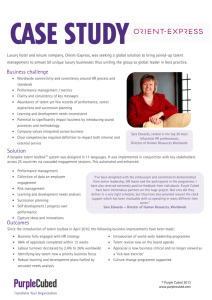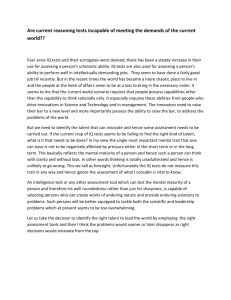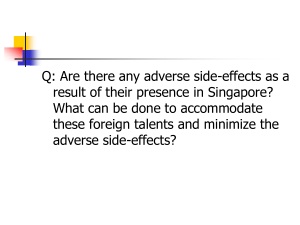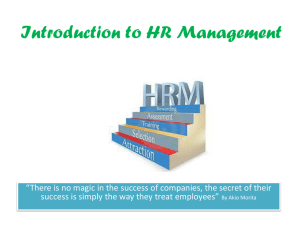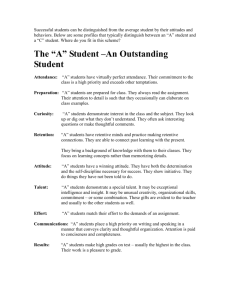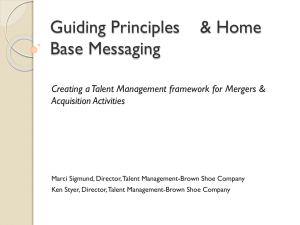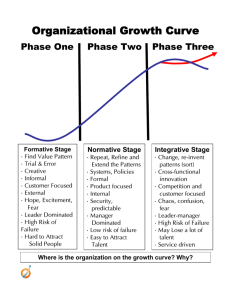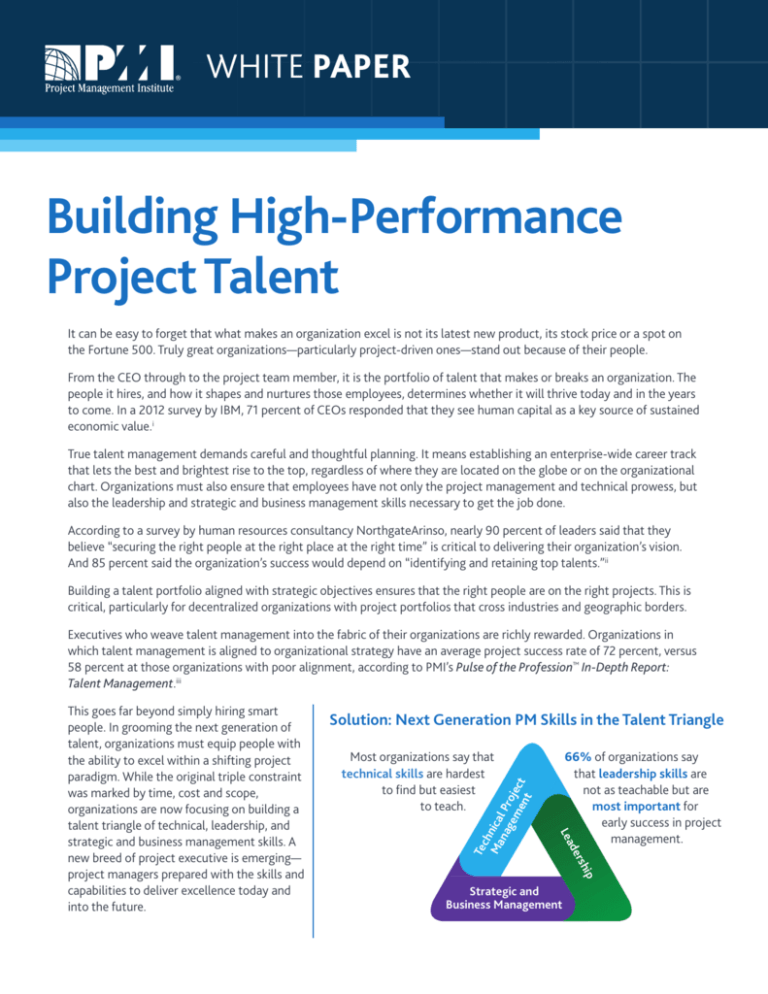
WHITE PAPER
Building High-Performance
Project Talent
It can be easy to forget that what makes an organization excel is not its latest new product, its stock price or a spot on
the Fortune 500. Truly great organizations—particularly project-driven ones—stand out because of their people.
From the CEO through to the project team member, it is the portfolio of talent that makes or breaks an organization. The
people it hires, and how it shapes and nurtures those employees, determines whether it will thrive today and in the years
to come. In a 2012 survey by IBM, 71 percent of CEOs responded that they see human capital as a key source of sustained
economic value.i
True talent management demands careful and thoughtful planning. It means establishing an enterprise-wide career track
that lets the best and brightest rise to the top, regardless of where they are located on the globe or on the organizational
chart. Organizations must also ensure that employees have not only the project management and technical prowess, but
also the leadership and strategic and business management skills necessary to get the job done.
According to a survey by human resources consultancy NorthgateArinso, nearly 90 percent of leaders said that they
believe “securing the right people at the right place at the right time” is critical to delivering their organization’s vision.
And 85 percent said the organization’s success would depend on “identifying and retaining top talents.”ii
Building a talent portfolio aligned with strategic objectives ensures that the right people are on the right projects. This is
critical, particularly for decentralized organizations with project portfolios that cross industries and geographic borders.
Executives who weave talent management into the fabric of their organizations are richly rewarded. Organizations in
which talent management is aligned to organizational strategy have an average project success rate of 72 percent, versus
58 percent at those organizations with poor alignment, according to PMI’s Pulse of the Profession™ In-Depth Report:
Talent Management.iii
Solution: Next Generation PM Skills in the Talent Triangle
66% of organizations say
that leadership skills are
not as teachable but are
most important for
early success in project
management.
ip
rsh
de
Tec
h
Ma nica
na l Pr
ge oje
me ct
nt
Most organizations say that
technical skills are hardest
to find but easiest
to teach.
Lea
This goes far beyond simply hiring smart
people. In grooming the next generation of
talent, organizations must equip people with
the ability to excel within a shifting project
paradigm. While the original triple constraint
was marked by time, cost and scope,
organizations are now focusing on building a
talent triangle of technical, leadership, and
strategic and business management skills. A
new breed of project executive is emerging—
project managers prepared with the skills and
capabilities to deliver excellence today and
into the future.
Strategic and
Business Management
Building High-Performance Project Talent
Such a shift requires new thinking on the human
resources front as well. In a 2013 survey by PwC,
77 percent of global CEOs said they anticipate
making changes to their talent management
strategies, with 23 percent planning major
shifts. iv
July 2013
83% of organizations report difficulty in finding
qualified project management candidates to fill open
PM positions in the past year.
100%
22%
At the same time, organizations are in the midst
of a project management talent crisis. Four
in five organizations report they’re struggling
to find qualified project managers to fill open
positions, according to Pulse talent data.
And those talent constraints will only grow. An
additional 1.57 million project management roles
will be created globally every year until 2020,
according to a 2012 study by PMI and Anderson
Economic Group.v
The stakes are high. Not having the right talent
on tap can diminish a company’s competitive
edge. According to the Pulse talent report,
organizations report that a lack of qualified
talent has led to a:
■■
■■
■■
50%
In the past year, has your
organization had difficulty
finding qualified people to fill
open positions in project
management?
43%
Yes, to a significant extent
Yes, to a moderate extent
18%
Yes, to a minor extent
No
17%
0%
Decline in quality (31%)
Inability to innovate effectively (29%)
Cancellation or delay of strategic initiatives (27%)
To stay competitive, organizations must align their talent management programs to their overall business strategy.
Fluor, a global construction and engineering firm in Irving, Texas, USA, syncs its five- to 10-year strategic business goals
and its talent management efforts to ensure its global portfolio of project professionals will satisfy future needs. A PMI
Global Executive Council member, the company tracks whether its current employees have the training, certifications
and experience to take on future roles, and fills any skills gaps with new hires. “You can’t create a high-performing project
manager overnight,” says Glenn Gilkey, senior vice president of human resources and administration.
Fluor also creates targeted learning opportunities for high-performing employees to help nurture the technical and
leadership skills they need to succeed at the organization. “We want to be around in a hundred years,” Mr. Gilkey says.
“Focusing on our pipeline of talent is how we will do that.”
That kind of strategic planning is especially critical in industries and regions where good project and program managers
are increasingly hard to find. More than a quarter of Pulse talent respondents said emerging markets need to develop
experience in project management.
For Fluor, it is simply a fact of life in today’s expanding marketplace.
“If we want to keep growing in the global markets we serve, particularly in emerging markets, we need to develop our
human capital pipeline today,” Mr. Gilkey says. “Because we need that talent in place when those projects kick off.”
2
Building High-Performance Project Talent
July 2013
Pulse data shows that qualified project professionals will gravitate to forward-thinking companies with targeted talent
management initiatives that include:
■■
■■
■■
■■
■■
■■
Defined career paths and skills requirements
Identification and grooming of top performers by senior management
Regular assessment reviews
Alignment between strategic goals, project portfolios and staff
Stretch assignments that give young project leaders opportunities to extend their skills, knowledge and
network
Mentoring and coaching
CASESTUDY TALENT MANAGEMENT IN ACTION
Organization: MD Anderson Cancer Center, Houston, Texas, USA
Industry: Healthcare
Lesson: Defined career paths improve retention in a competitive job market and show the value of project management
talent to senior management.
When the University of Texas MD Anderson Cancer Center launched its project management office (PMO) in 2004, it
defined the competencies, skills and experiences required to be a project professional at the organization. It then aligned
those skills and experiences with the organization’s IT project management career ladder.
The PMO also created a tiered structure of project management seniority with specific competencies, tasks, experiences
and training requirements for each level:
1. Associate project manager: Plans, organizes, monitors and leads small teams responsible for delivering
defined projects, enhancements or sub-projects. Four years of experience (including one year of project
management), with PMI Certified Associate in Project Management (CAPM)® certification or Project
Management Professional (PMP)® credential preferred.
2. Project manager: Manages all aspects of moderately complex medium- to large-scale projects spanning
two or more organizational boundaries. Eight years of experience (including five years of project
management), with CAPM® certification or PMP® credential preferred.
3. Program manager: Oversees and supports programs and processes across the institution. Seven years of
experience required.
4. Senior project manager: Manages all aspects of highly complex medium- to large-scale strategic projects
that span three or more organizational boundaries. Ten years of experience (including five years of project
management), with PMP credential required.
From there, employees can move to project director, directing and managing multiple interrelated implementations, or
portfolio manager, managing governance and project management processes, methodologies and tools. Both positions
require 10 years of project management experience and a PMP credential.
The center has most recently promoted three people from purely technical titles to associate project manager, five from
analyst titles to project manager, and two from project manager to senior project manager and now portfolio manager.
Establishing a defined career path shows project professionals that they are a valued part of the organization, says Patti
Layne, PMP, the center’s director of project support and coordination services. It also gives employees the tools to chart
their careers and helps them map out a development plan with their managers to fill competency gaps.
3
Building High-Performance Project Talent
July 2013
For organizations, a robust talent management program and defined career path often provides an advantage over rival
companies looking to poach the best people. “In this market, it’s not uncommon to grow a project manager and then lose
them,” Ms. Layne says.
Offering training, tuition assistance and growth opportunities can keep them motivated to stay. “It’s a soft benefit that
helps us with retention,” she says.
Defining the project management career ladder and talent management process has also demonstrated to leadership
how critical project professionals are to the enterprise. “We had to legitimize the role, as we do with any other job,” Ms.
Layne says. “That meant educating the organization that this is a pool of individuals with important competencies who
add value.”
BETTER TALENT, BETTER PROJECTS
Effective talent management leads to satisfied staff and, more importantly, better results. Employees who were most
committed to their organizations gave 57 percent more effort and were 87 percent less likely to resign than employees
who consider themselves disengaged, according to a study by the Corporate Executive Board.vi
The National Aeronautics and Space Administration (NASA) sees a direct connection between talent management and
the success of projects, says Ed Hoffman, PhD, director of the NASA Academy of Program, Project and Engineering
Leadership (APPEL) and Chief Knowledge Officer, Washington, D.C., USA.
NASA’s talent management program involves four phases, with a focus on hands-on experience supplemented by
training. Individuals typically begin their NASA career as part of a team, bringing their expertise and experiences to
support a larger project. Some then move to leading a subsystem project or component activity, which will serve as
an early testing ground of capability and learning. If they do well in this phase, they are on track for more complex
assignments and leadership roles, Dr. Hoffman explains.
At the next phase, they work at the program level to monitor and support project success, and ensure each project aligns
with the program’s direction. Finally, at the portfolio level, they work to define, communicate and ensure the portfolio
aligns with the organization’s strategy.
Any team can request assistance for a project via an online assessment of team performance and a three-day workshop
tailored to that team’s requirements, Dr. Hoffman says. APPEL launched in the 1990s in an effort to improve results
after a string of project failures. “We realized our teams didn’t always have the support structure they needed to be
successful,” he says.
The Academy brings project management experts onto functioning teams to help them identify problems and create
processes that improve their overall performance. “It’s critical to have that expertise available to them,” Dr. Hoffman
says, “because how well teams work together determines their success or failure.”
To gauge the benefit of the program, the assistance team performs an initial assessment of project performance and
then reassesses them over time to track improvement. Dr. Hoffman says about 200 teams take advantage of the team
assistance option each year, and follow-ups show steady project progress.
At MD Anderson Cancer Center, their PMO based its case for investing in project management talent on numbers. The
organization ran a project using a full-time professional project manager, then created a baseline of results from previous
projects run by part-time project managers, highlighting variances in scope, schedule and budget. The full-time project
manager demonstrated much better results around scope, schedule and budget, Ms. Layne says, further cementing
support for the organization’s project management career path. “The executive team recognizes that our talent
management efforts are improving project delivery.”
4
Building High-Performance Project Talent
July 2013
Pulse talent data echoes those sentiments, revealing that establishing a career path for new project management hires
increases project success rates to 67 percent, from the study average of 64 percent.
Providing education to build expertise—and thereby boost performance—is fundamental to crafting an effective talent
portfolio. Although 72 percent of organizations report employee training as a high priority, only 44 percent have a
formalized training program for project managers, according to the Pulse talent report. And 48 percent of organizations
report that employee training programs have been scaled back due to recent economic conditions.
Embedding skills development across the organization is particularly critical at Indra, particularly given the decentralized
nature of the Madrid, Spain-based IT systems and engineering company. Each business unit closely guards its own talent,
with project professionals growing within those departments throughout their career, says corporate PMO director
Enrique Sevilla Molina, PMP.
Instead of moving talent across departments or regions when a need arises, Indra’s human resources department and the
corporate PMO provide regular development opportunities so every department’s pool of project management talent
can meet all of the unit’s project requirements.
The human resources department and the corporate PMO outline the specific skills and competencies for each level of
project management expertise and assess project managers against those definitions.
“The annual performance evaluation is based on the job descriptions, the maturity achieved so far, and the gap between
the expected performance for the role and the actual performance,” Mr. Sevilla explains.
Training needs for each level are also reviewed every year, with courses targeted specifically to the individual’s core
market, job functions and language skills.
MD Anderson Cancer Center also keeps careful watch on where its talent pool performance syncs with its project needs—
and where it deviates.
“Tracking our talent development process prevents us from putting someone in charge of a high-priority project who
doesn’t have the right skills to succeed,” Ms. Layne says. In some cases, the organization may delay major projects until
the best candidate becomes available.
CASESTUDY TALENT MANAGEMENT IN ACTION
Organization: National Aeronautics and Space Administration (NASA), Washington, D.C., USA
Industry: Aerospace
Lesson: Executive support helps mold the next generation of project leaders.
Looking to prep its up-and-coming project talent for leadership roles, NASA, a PMI Global Executive Council member,
implemented Project HOPE (Hands-On Project Experience). The initiative lets less-experienced team members run a
project from proposal through execution over the course of a year.
“At NASA, capability drives performance,” says Ed Hoffman, PhD, director of the NASA Academy of Program, Project and
Engineering Leadership and Chief Knowledge Officer. “We follow a foundation belief that hands-on experience is a key
component of that.”
Winning project ideas are selected from employee submissions and assigned funds and a stakeholder group, with the
project managers then held responsible for the results. In 2010, NASA employee Jennifer Dungan and her team launched
5
Building High-Performance Project Talent
July 2013
a HOPE project to develop airborne remote sensing instruments to gather data about coastal zones. The goal was to
learn more about that environment and test the feasibility of the technology.
With little project management knowledge at the time, Ms. Dungan initially found the experience to be daunting.
“Scheduling and budgeting are not something research scientists are good at,” she says.
The first few months were marked by struggle: the team was small, the roles were not clearly defined and Ms. Dungan
was expected to deliver progress reports to the directors every two weeks.
When executives saw that things were not going as planned, they stepped in to help. The chief engineer directed her staff
to provide the team with a mechanical engineer and someone with project scheduling expertise, and research directors
provided other experts for crucial roles on the team.
“It turned the tide of the project,” says Ms. Dungan. “I don’t think we could have been successful without their help.”
Ms. Dungan continues to work at a NASA research facility in California, where she uses her sharpened project
management skills to better manage budgets and schedules and write proposals. It has also spurred her to sign up for
more project management training and to apply for project-driven opportunities within NASA—fulfilling the ultimate
goal of the program.
“It’s a key part of the learning process and, hopefully, they take that experience back to their own positions and stretch
more,” says Dr. Hoffman.
SCOUTING FOR TOP TALENT
Organizations with project portfolios that span geographies and industries face added pressure to create talent
management programs that help with skills growth. Those organizations must be able to align their project professionals
with appropriate endeavors, often on short notice.
At any given time, 10 percent to 15 percent of NASA’s approximately 120 internally certified project managers are not
leading a project, a move aimed at maintaining flexibility, Dr. Hoffman says. “[NASA] wants more project managers than
it needs so that when something opens up, we have the ability to immediately move the right people into place.”
The most effective talent management efforts are built to adapt, able to respond to a company’s changing needs.
To ensure its talent portfolio is aligned with growth projections, Fluor uses a matrix of online talent management forums
in which company leaders mentor and track high-performing employees. Roughly 10 percent of the company—4,500
employees—is monitored through the forums, including many on the project management career track.
Such talent management oversight lets the company see at a glance where its best talent is and also identify any gaps,
says Mr. Gilkey. For example, the company is currently focusing on building its talent pipeline in South America and Asia
to support anticipated expansion in these regions over the next decade.
Fluor prefers to develop its project management staff rather than wait to hire when the need arises. “That way, we know
we will have the talent in place to match the projects when they come in,” Mr. Gilkey says. The company initially uses
expatriates in lead roles where there are talent shortages, but has been able to gradually build local talent pipelines.
Indra’s management units, for example, nominate exceptional project professionals for more rapid talent development,
says María Del Carmen Moneva Montero, manager of human resources development. “We focus on identifying the most
challenging assignments for them and look for opportunities for internal experiences so that they can develop a broad
global vision for the business as they move up in the company,” she says.
Funneling the right people into these fast-track development opportunities is not solely the purview of the PMO
or human resources, however. Executives must also recognize high-potential individuals. When such individuals are
6
Building High-Performance Project Talent
July 2013
identified, they need senior-level champions to guide them and make sure they get opportunities to grow. The Pulse
talent report shows that 39 percent of organizations have a mentoring program, and 53 percent report that they should
be using mentoring more than they currently do.
At Fluor, it is the executive team’s formal responsibility to mentor the next generation of project superstars. “Our talent
management process doesn’t cost a lot of money, but it does require a lot of time on the part of the leadership team,”
Mr. Gilkey says.
A select number of high performers are put onto a global business leadership track, to be mentored by executive leaders
and sent to intensive project management training programs. They are also given opportunities to rotate into new
projects and take on stretch assignments in a structured program designed to expand their skills and experiences.
To further ensure the talent portfolio is aligned with project needs, Fluor encourages leadership to move project
managers among divisions, even if it means giving their best talent to another group.
“People here are rewarded for exporting talent. It’s part of our culture,” Mr. Gilkey says. In fact, leaders are assessed on
how many structured opportunities they create for their team members. “They are held accountable for the development
of their people, and I’ve seen careers plateau when they don’t share those resources.”
CASESTUDY TALENT MANAGEMENT IN ACTION
Company: Fluor, Irving, Texas, USA
Industry: Engineering and construction
Lesson: Focused training and stretch opportunities help build project leaders.
Fluor spotted potential in Mark T. Brown. But the company also knew he might need some help to reach true project
management superstar status.
So Mr. Brown became one of the participants selected by a senior project manager to participate in Fluor’s global
business leadership track. The first thing the development team did was assess Mr. Brown’s skills. Because he already
had extensive construction and engineering experience, his training focused on expanding his project planning and
execution skills. Fluor also recognized the need for people skills, and helped Mr. Brown hone his leadership abilities and
communication techniques for working with clients and team members.
This began with a role in the sales department for oil and gas projects. “I needed to expand my knowledge of the whole
project life cycle, beginning with the pursuit of the client and execution skills,” Mr. Brown says. He spent 18 months
learning how the company secured projects, wrote bids and established execution plans for clients during the proposal
stage.
When that rotation was complete, his annual talent analysis performance review indicated he still would benefit from
expanding his scheduling, risk management and project delivery skills. So Mr. Brown was added to a team in charge of a
billion-dollar project in the Netherlands to relocate a chemical plant to make way for an airport expansion.
The move was a win for both the company and the up-and-comer.
“It wasn’t just about Fluor giving me a opportunity to fulfill a new role,” he says. “I added value to the project and the
project team by leveraging all my previous experiences.”
When the project moved to the field, Mr. Brown led the development of the finance package and front-end planning to
build a gas storage plant in the Netherlands. He was responsible for all client and Fluor stakeholder communication,
7
Building High-Performance Project Talent
July 2013
leadership, legal implications and financial management issues. “It was definitely out of my comfort zone, but it was a
great experience that provided additional opportunities to broaden my skill set,” he says.
Mr. Brown stayed with that project for another year. He then returned to Texas, where he is now part of Fluor’s corporate
portfolio group tasked with helping develop processes to link the company’s construction and project management
approaches, and ultimately improve and expand its construction business.
Now, as director of construction, he is mentoring the next generation of Fluor project leaders.
“When I was in the sales group, I had a coach tell me, ‘Your success depends on the success of the people around you,’”
Mr. Brown says. “Now that’s my motto, and I do everything in my power to give other people opportunities to gain
experience.”
RULES OF ENGAGEMENT
When implementing or improving a project talent management program, organizations should:
■■
Hold leaders accountable for developing the next generation. “At Fluor we have 600 executives who are
our internal talent scouts,” says Fluor’s Mr. Gilkey. “Having a culture where people want to help others
succeed can’t be understated.”
■■
Look for passion and confidence as signs of high performers. Although leadership should provide training
and new kinds of opportunities, the ideal individuals will pursue education, credentials and experiences on
their own, says NASA’s Dr. Hoffman.
■■
Build a support structure that nurtures young talent. Everyone makes mistakes, and when new project
managers are put into stretch assignments, it increases their risk of failure. “Make sure they have a
network and leadership guidance so they have someone to turn to when they need help,” Mr. Gilkey says.
■■
Educate the organization about the value of project management skills in meeting strategic goals. When
companies align their talent development efforts with business results, people pay attention, says MD
Anderson Cancer Center’s Ms. Layne.
■■
Plan ahead. It takes years to build a project management talent pipeline, and companies should be
consistently developing the right skills in the right regions, says Fluor’s Mr. Brown.
CONCLUSION
Developing top-tier project talent does not happen overnight. Organizations must invest time and resources to identify
high-potential project and program managers and give them the training and opportunities they need to advance. That
process works best when it begins early and continues throughout the individual’s career.
“It takes a decade or more to build a great senior project leader,” says Fluor’s Mr. Gilkey. “The first three to 10 years of a
person’s career is when you can get them on the right trajectory.”
When companies invest in project professionals at the beginning of their careers, those individuals will more rapidly
increase their skills and experiences, bringing value to the company in the present—with the promise of even greater
returns in the future.
“Aligning the best talent with projects and business needs is mission critical to a company’s success,” says Indra’s Mr.
Sevilla, “and it attracts future professionals by reinforcing the talent brand.”
8
Building High-Performance Project Talent
i
July 2013
2012 Global CEO Study, IBM, 2012. Based on interviews with more than 1,700 CEOs.
ii Global Talent Management Survey 2013, NorthgateArinso, 2013. Based on interviews with more than 1,100 executives and human resources
practitioners.
iii Pulse of the Profession™ In-Depth Report: Talent Management, Project Management Institute, 2013. Based on research conducted in
January 2013 with 277 project, program, and portfolio management directors, managers, and practitioners who make or strongly influence
hiring decisions for project, program and portfolio managers for their organization or who design and/or administer their organization’s talent
management program.
iv 16th Annual Global CEO Survey: Dealing with disruption, Adapting to survive and thrive, PwC, 2013. Based on interviews with 1,330 CEOs in
68 countries.
v Project Management Talent Gap Report, Project Management Institute and Anderson Economic Group, 2012.
vi The Role of Employee Engagement in the Return to Growth, Corporate Executive Board, Bloomberg BusinessWeek, August 2010.
© 2013 Project Management Institute, Inc. All rights reserved. “PMI” and the PMI logo are marks of Project Management Institute, Inc.
For a comprehensive list of PMI marks, contact the PMI Legal Department. BRA-003-2013(07/13)
9

